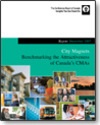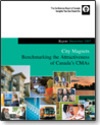Urmi in Urban Issues, Lifestyle
In case you missed it last month, the Conference Board of Canada issued yet another headline-tailored missive, this one heralding a new report on which Canadian cities are most "attractive" to people. From the executive summary (the full report is available for $2,400): City Magnets: Benchmarking the Attractiveness of Canada’s CMAs gives an overview of how cities rank on the features that make Canadian cities attractive to skilled workers and mobile populations. A looming demographic crunch threatens to generate labour shortages in Canadian cities, so cities without the ability to act as magnets and attract new people will struggle to stay prosperous in the decades ahead. The full study uses report-card rankings of outcomes, or proxies for outcomes, to show how attractive our cities are to people. The performance of 27 census metropolitan areas is compared across seven different domains: Economy, Health, Society, Housing, Environment, Innovation, and Education. A second, less detailed analysis, also ranks Canada’s 27 CMAs against 27 U.S. cities.
City Magnets: Benchmarking the Attractiveness of Canada’s CMAs gives an overview of how cities rank on the features that make Canadian cities attractive to skilled workers and mobile populations. A looming demographic crunch threatens to generate labour shortages in Canadian cities, so cities without the ability to act as magnets and attract new people will struggle to stay prosperous in the decades ahead. The full study uses report-card rankings of outcomes, or proxies for outcomes, to show how attractive our cities are to people. The performance of 27 census metropolitan areas is compared across seven different domains: Economy, Health, Society, Housing, Environment, Innovation, and Education. A second, less detailed analysis, also ranks Canada’s 27 CMAs against 27 U.S. cities.
The Board crowned Calgary the winning bachelor, with Toronto, Vancouver, Edmonton, Victoria and Ottawa-Gatineau following behind (in that order). But the contest's banner is a bit of a misnomer. While purporting to be an overall assessment of a city's "attractiveness", the principle factor being measured is economic growth, i.e., 'where high-skilled people choose to go'. As Blog TO puts it: "Calgary got top honours because oil is good for health, housing, the environment, education, innovation and society."
I have previously written about the questionable utility of ranking exercises conducted in or by the media, but I agree that they are fun to look at as a starting point for job hunting or HomeBuying research. While I suspect that the Board's work may feature some confused variables at play, the findings are nonetheless interesting. For one, they highlight the discrepancy between how an economist and a citizen might view the decisions we make - particularly when it comes to where we choose to live.
Given that unemployment is harder to weather than lack of community or an arts scene marked by tumbleweed, are people choosing Calgary and Toronto or are they being pushed from cities facing economic decline such as St. John, New Brunswick and Stephenville, Newfoundland? And once we decide to move to a new city, don't we, being the highly adaptable creatures that we are, tend to rationalize our moves in the first place? A move for a job can quickly become a move for good health care, better schools and safer communities (just listen to a friend heading south of the border). Defining the principal 'push' or 'pull' that brings us to a particular city is a tricky business.
Richard Florida's work on cities focuses on particular pull factors - like diversity and social freedom - that bring the "creative class" (anyone from IT workers to ballerinas) to winning cities. So do these qualities trump things like job availability, affordable housing and low crime? Maybe, maybe not. A recent exchange on Florida's blog is telling:
Florida: And Dave, stop drawing a false divide between "cool cities" and "creative class" stuff on the one hand and the "important boring stuff" like low crime, good schools, and affordable housing. You sound a lot like Joel Kotkin and Fred Siegel and they already have that ground covered. The two go hand in glove, as I've long argued. Des Moines is all the proof we need of that. It's a solid - dare I say creative - model other medium-size communities would do well to follow.
...
Steele: [Milwaukee has] pursued a policy of attracting new, wealthier residents through a revitalized downtown and core neighborhoods. But half the city remains mired in unemployment, plagued by poor schools and high crime. We have done more than many other cities to attempt to address these problems, but it's a lot more difficult to impact these issues than it is to build up our arts and creative scene.
In Milwaukee, I don't see the pursuit of the "creative city" and the "boring stuff" of education and quality of life as a false distinction. It is a real distinction that continues to prevent us from making a sustainable economic transformation as a city and a region.
Des Moines has an easier go of it. They don't have the "city within a city" that Milwaukee and so many other cities do. I would submit that its Des Moines' lack of endemic economic and social problems that is propeling [sic] its rapid growth, not it's "creativity index."
It's a fascinating puzzle. Even the Economist, normally strident in its analysis, offered up a smattering of explanations when it reported last year that New York City is experiencing the largest drop in the city's black population since the civil war - with transplants going as far as Atlanta, Florida and the Carolinas. In addition to economic and cultural factors, the magazine held that "the sunshine can't hurt, either." One could argue that New York's insane real estate market, pointing up when most of the country is down, is what really hurts.
Given the complexity of both human behaviour and cities, studies will continue to focus on some factors to the exclusion of the others. This may explain why Washington, D.C, Austin, Texas and Calgary alone get an "A" in the Conference Board's "less detailed" comparison of Canadian and U.S. cities.
Is it the details which get the in-laws excited - good jobs, decent housing options and safety - that make a city attractive to us, or its roguish charms? Which can't we live without - and which do we have to?
Urmi Desai is an economic analyst and a freelance writer specializing in urban issues. She is editor of the Move Smartly blog. Email Urmi




